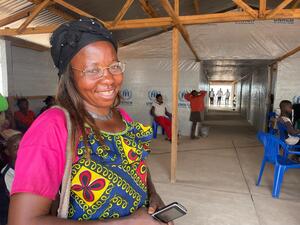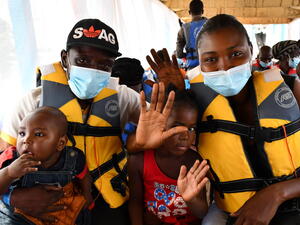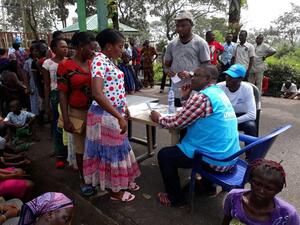Sierra Leone: reintegration projects for Guinea returnees
Sierra Leone: reintegration projects for Guinea returnees
UNHCR has set up reintegration projects for returnees and internally displaced persons in areas of Sierra Leone where spontaneous returns have increased due to recent insecurity in the refugee-hosting areas of Guinea. In Lungi, some 30 km north of Freetown, UNHCR is assisting close to 10,000 former refugees who returned by foot or bus from conflict zones along the Guinean border. They integrate within the local communities, since a majority of them originate from rebel-held districts of Sierra Leone (mainly Port Loko and Kambia districts). Some of them had been hiding in the bush for two months after leaving Forécariah in south-western Guinea where several attacks took place.
Returnees are being hosted in eight villages of the Lokomassama chiefdom in the Lungi Peninsula of Sierra Leone, where UNHCR will open an office to establish a stronger presence. Local chiefs were given bicycles to help monitor population movements and community-based programmes are underway in the field of health, water and sanitation, agriculture and education to assist returnees as well as hosting communities. During a mission last week to Lungi, UNHCR officials found returnees in need of supplementary food and medical assistance. While promising more aid, UNHCR has also encouraged them to try to gain a certain degree of self-sufficiency by using the land and agricultural tools given to them.
A similar reintegration project will be launched soon in the Kenema district, where at least 5,000 returnees have been identified. UNHCR is awaiting approval from the Sierra Leone government to start construction of a transit camp from which returnees could be similarly assisted to resettle in the local communities.
Meanwhile, the rate of arrivals by boat from Guinea has decreased significantly with only the Government-sponsored ferry transporting Sierra Leonean nationals from Conakry. However the number of people of concern to UNHCR has increased dramatically reaching 80% of passengers on the last ferry, many of whom came from the refugee camps in Guéckédou in south-eastern Guinea. On Monday this week, 2,000 people arrived by boat, bringing to 17,000 the total number of returnees on 37 boats since September. Out of these, more than 4,000 are former refugees of whom three-quarters need temporary accommodation, which UNHCR is providing in a transit centre outside Freetown. A second transit centre should be opened soon to increase our temporary hosting capacity to about 2,000, pending reintegration in a safe area of Sierra Leone.
Spontaneous returns by land and by boat may have significantly decreased the number of Sierra Leonean refugees in Guinea, which stood at 330,000 before the series of border attacks in September and the following restrictions imposed on refugees in Guinea.








